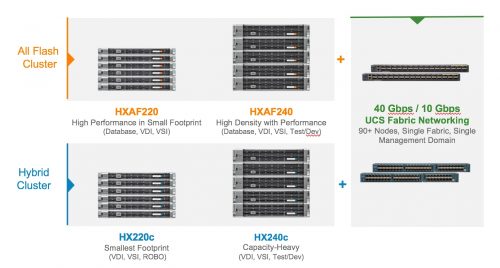
HyperFlex 2.0 the next wave … and it continues
During the last 12 months a lot of things have changed and added to the HyperFlex system. Let me try to summarize the different highlights of the current wave of HyperFlex 2.0 here.
What has changed?
At general availabilty the HX Data Platform software the version was 1.7.1. Since September of 2016 version 1.8.1 is out and added some new features to it. But not only with a new version of the HX Data Platform software, enhancements and features are made possible. Through leveraging the strength of UCS architecture and products and extending product qualifications into the HX-Series products, it was possible to also provide new hardware support, interoperability qualifications or adding other licenses for the hypervisor.
- New Intel E5-2600 V4 CPU (Broadwell): Almost at the same time when announcing the new Intel CPU for UCS B- and C-Series, this was also available for ordering for the HyperFlex Platform
- NVIDIA GPUs: To provide a better graphical experience and performance for VDI environments only 2 months after availability of the HX Data Platform, these cards were qualified and supported.
- vSphere licensing: Helping to reduce the costs is one of the goals using a hyperconverged platform. With the support of vSphere ROBO Edition, Essential Plus and Standard, additional to the Enterprise+ license, the customer can choose between the license he really needs for the hypervisor integration and does not depend from the version the hyperconverged platforms demands.
- C-Series as compute only: Additionally to the UCS B-Series blades, that were available to scale with compute only nodes, C-Series 220 and 240 servers were qualified to be used as compute only nodes.
- Non HX-UCS Support: You can extend your HX UCS domain with B-Series and C-Series to protect your investment and integrate it into your centralized UCS management.
- External Storage Support: As you can now extend with non HX UCS components, you may want to access external storage through this servers. This is supported either directly attached to the UCS Fabric Interconnects (FIs), through a Fibre Channel SAN or iSCSI DC Switch attached to the FIs. The vSphere Cluster on the HX Platform can as well access the external storage in case the demand is there to use block storage access for the Datastores the VMs are accessing (e.g. MS Exchange).
These enhancements did have nothing to do with the version 1.8.1 that was made available September 2016. With 1.8.1 we introduced
- Improved Installer Capabilities: You now enter all the necessary information into the installers form and it will create all the necessary prerequisites on the VMWare, UCSM and as well do the needed post install configuration on vCenter and the ESXi servers. In 1.7.1 you had to do the preparation manually and then start the installer with the provided input. We achieved with that a deployment of an HX cluster in only 34 minutes. More details can be seen on this video HyperFlex Deployment in 34 minutes.
- Non-disruptive Rolling Upgrades of UCS Firmware and HX Software.
- UCSM Version 3 support with the HTML 5 Interface
- Preview for the HyperFlex HTML 5 native interface and the REST API
- Continuous improvements in resiliency and performance
- Cluster health reporting and monitoring simplification
- Snapshot lifecycle improvements
And now after all these enhancements in the last 12 months, we finally have received version 2.0 of the HyperFlex Data Platform Software. With this new version we have released following new functions and features:
- HX AllFlash converged Nodes (HXAF220c, HXAF240c) that are now populated with AllFlash and provide consistent low latency and high performance out of a hyperconverged platform. Having this in the portfolio, the use case of putting databases on it can be made real. The first white paper about HyperFlex and MS SQL Server databases on it can be found here Cisco HyperFlex 2.0 All-Flash Storage and Microsoft SQL Server Best Practices.
- Support for 40Gb Fabric Interconnects is here. With AllFlash integrated to it, not only high performance data access is possible but as well improved bandwidth for the access of the VMs and improved performance of the data network is now here.
- Support for HX Nodes in existing UCS domains: Now we can extend and support existing UCS domains with HX nodes and with it, the UCS compute architecture at customer sites can use the right workloads on the right platforms (native compute/storage, converged infrastructure, hyperconverged or scale out) under the same management tools, automation. No silos are present anymore for the complete compute and storage architecture.
- External storage installer is now integrated into the HX installer and at creation of a HX cluster you can as well get configured with external storage connectivity and policies for iSCSI or Fibre Channel.
- Snapshot integration in REST API allows now, to integrate automation of different workflows and tasks to leverage the strength of HyperFlex native snapshots. Veeam with version 9.5.2 will be the first implementation to use this and more will follow.

As you have been able to read, the HyperFlex platform is more than only a hyperconverged infrastrucutre. It enhances the compute/storage infrastructure with the right sized workloads at a better TCO and eliminates the need to create silos. And we are not done yet! During this year there already a big funnel of new ideas, features and enhancements that will be integrated in an agile and flexible way into the HX platform. Stay tuned the next wave will come for sure …
If you are interested in some details of the HyperFlex 2.0 announcements, you can watch the recording of the HyperFlex Live Webinar of March 29th 2017.
Tags:


